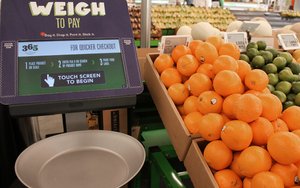retail
Cheaper Produce, 'Grocerant' Trend Powering Whole Foods' 365
- by Sarah Mahoney @mahoney_sarah, July 5, 2016
 While its first 365 store has been open only a month, Whole Foods Market executives gave investors a peek into what’s working, and it looks like its
“grocerant” offerings, like the vegan By Chloe restaurant, are an early hit.
While its first 365 store has been open only a month, Whole Foods Market executives gave investors a peek into what’s working, and it looks like its
“grocerant” offerings, like the vegan By Chloe restaurant, are an early hit.
In a presentation at the Oppenheimer Consumer Conference, Whole Foods executives -- including co-founder and co-CEO John Mackey -- revealed some insights. While declining to give sales figures, he did say: “We had to add two more cash registers to the front end, and we’re very happy.”
He says the company is busy trying to quickly translate its experience in the first stores as new ones open. For instance, “we didn’t have conveyer belts, because we thought we’d get smaller basket size. But it’s been the opposite.”
advertisement
advertisement
And as expected, he says the majority of the store’s business is happening at night, which is also when it’s most likely to be full of Gen Y shoppers. “I was eating at By Chloe, which is doing very well, too. And I was the only person there over 30.”
Conventional grocers are also targeting Millennials’ fondness for in-store dining. NPD Group says the sale of takeout prepared foods from grocery stores has jumped about 30% since 2008, amounting to $10 billion in spending in 2015, and about 2.4 billion foodservice visits. And consumers say they like eating in grocery stores better than fast-food restaurants, citing fresher food and more varied experiences.
Mackey says Whole Foods is continuing to use produce as the main differentiator at 365. “We’ve doubled down on that, and it is driving overall sales.”
The main difference between the two, he says, is that 365 is cheaper, “with 7,000 SKUs, not 25,000.” Because labor costs are much lower — there is less service in the meat and seafood departments, for instance — they are also less expensive to run. He says that even with less staff, they are doing just as much business as those departments in its regular stores.
And he says it seems clear that the store is attracting a different kind of customer. “I never saw so many Trader Joe’s bags. I joked that we should offer to trade them in, two for one, for our bags, but the team decided that would seem too unfriendly.”
At this point, there’s no insight yet on potential cannibalization, because the nearest Whole Foods isn’t close by. But when its store No. 3 in Bellevue Wash., scheduled for September, is a mile from the nearest Whole Foods, “that will tell us more.”
When asked about competition from online grocers, Mackey says that while those companies get plenty of attention in the media and from investors, “the biggest threats are legacy supermarkets, such as HEB and Kroger’s.” Part of Whole Foods’ success has been its “unique products, so people will drive further.” But with so many more stores offering natural and organic foods, “they don't have to drive. So convenience is a big factor.”


